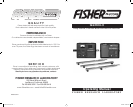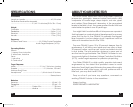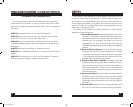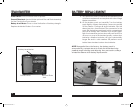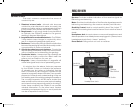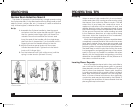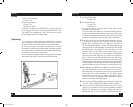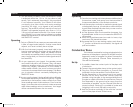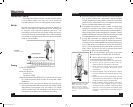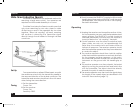
10
SEARCHING
7. You are ready to search when the BALANCE knob
is adjusted within the 1/8- to 1/4-turn silence (null)
space. This is extremely important! If this procedure
is not followed correctly, the GEMINI-3 will either
constantly give false audio and meter readings
(sensitivity too high), or no signals at all (sensitivity
too low). The sensitivity will be correctly set and your
GEMINI-3 will operate properly only when a 1/4- to
1/8-turn null has been achieved. If you lower or raise
your GEMINI-3, you may have to retune by making
repeated adjustments to the BALANCE knob and/or
the SENSITIVITY control.
Operating
1. Test your GEMINI-3 in an area you are reasonably sure
is free of large buried objects. Scatter some metal
objects, such as a tool box, piece of pipe.
2. With the instrument properly tuned and held in the
hand or suspended by the strap, slowly walk directly
toward your test object. Keep the handle as level
and steady as possible while in motion or the tuning
may change and you’ll receive false signals and/or
lose sensitivity.
3. As you approach your target, the speaker sound
and meter indication will increase. They will reach
maximum readings when you are directly over the
conductor (target). Remember, on the GEMINI-3,
unlike earlier models, the sound volume and pitch
continue to increase after the meter pegs. This allows
you to pinpoint without constantly readjusting the
SENSITIVITY knob.
4. As you cross the target, the signal indications will begin
to decrease because you are moving away. To get a
precise x on the location, make a mark at your feet
when readings reach their maximum. Cross over the
target, turn around and come back. Make a second
mark when readings return to maximum. Your target
will be centered between the two marks.
15
TRACING
Operating
1.
Once the two starting points have been established and
the receiver tuned, walk away from the transmitter in
the assumed direction of the buried conductor.
2. Hold the receiver vertically to maintain a peak signal
or horizontally, face up, to maintain a null or minimum
signal. Either method indicates that you are over the
object and tracing its path.
3. As the distance from the transmitter increases, the
signal will fade. As this occurs, increase the SENSITIVITY
as required.
4. When the signal becomes too weak to trace, stop
and move the transmitter closer.
5. Be aware that if you are tracing a pipe, each time a
“T” junction or lateral is encountered, the signal will
split and weaken.
Conductive Trace
This is the best method for tracing a single pipe in the
presence of other pipes. A portion of the pipe must be
exposed in order to energize it by direct connection
utilizing the optional Ground Plate Assembly or
Ground Rod Assembly.
Set Up
1. If possible, clean the contact point of the pipe with
a wire brush.
2.
Connect the ground plate clamp to the contact point.
3. Plug the Ground Plate Assembly or Ground Rod
Assembly into the transmitter Ground Plate Jack.
4. Set the transmitter on the ground and in an upright
position as far away from the contact point as
possible, at right angles to the assumed direction of
the pipe or cable. Insert the Ground Plate or Ground
Rod Assembly in the ground as far away from the
transmitter as possible. Lay the Ground Plate at on
paved surfaces. Placing it in a puddle of water and
weighing it with a rock will help conductivity.
5. Hold the receiver vertically, in line with the contact
point of the pipe at least 30 feet away.
Gemini-3manual-.ind2 10 6/13/06 2:52:52 PM



